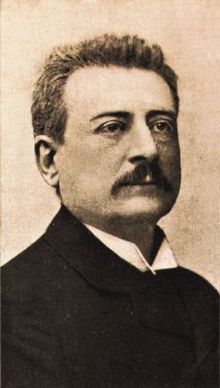235:
bonds between the particles. These studies by
Calzecchi predate by nearly six years those of the French physicist Edouard Branly and Oliver Lodge in England, although they are largely credited with the discovery. At the time, Calzecchi saw this as an invention for detecting lightning and as a seismic detector, but a lively debate followed when Branly, Lodge and Marconi used the coherer for radio.
222:
were made, including the transmission of telegraph signals without wires. Since 1884 Calzecchi had been researching the properties of metal powders, finding high electrical conductivity due to various excitations such as extra current, lightning, electrostatic induction, etc. Calzecchi's experiments
234:
This unit consists of a glass tube containing powder and nickel silver with traces of mercury, placed between two steel electrodes in vacuum. When it is hit by electromagnetic fields, the high resistance of the powder becomes relatively low until it is "percussed"—that is, hit, to break the welded
31:
195:, at the expense of the City of Fermo and the Central Office of Meteorology and Geodynamics, organizing a weather information service for the region. In 1888 he moved to the Beccaria school in
180:
Calzecchi graduated from the
University of Pisa after studying the physical sciences and mathematics, then devoted himself to teaching in high schools and then scientific research.
123:, was temporarily working at the time. His mother, Angela, was the last descendant of the ancient and noble Onesti family. His first name is the Italian version of the
191:. In 1884 he began his studies of electrical resistance and conductivity of metal filings. In 1886, he founded a Physics Laboratory at the High School, including a
291:
281:
286:
266:
211:
192:
177:
Monterubbiano was his home, where he spent his youth, studied, and spent other periods of his life, and died.
250:
206:, testing the installation of electric lighting in Fermo. Meanwhile, the great physics discoveries of
276:
271:
139:
162:
203:
146:
223:
with tubes of metal filings led to the development of the first radio wave detector, the
138:
contained in an insulating tube will conduct an electric current under the action of an
228:
207:
158:
260:
219:
120:
84:
69:
183:
On 6 December 1879 he was appointed
Professor of Physics at the Istituto tecnico at
215:
154:
135:
128:
244:
184:
30:
143:
108:
80:
112:
88:
51:
224:
150:
124:
119:, where his father, Icilio Calzecchi, a medical doctor from nearby
196:
188:
166:
116:
134:
Calzecchi demonstrated in experiments in 1884 through 1886 that
142:. This discovery was the operating principle behind an early
187:. In 1883 he transferred to the Liceo Classico "A. Caro" in
107:(14 December 1853 – 25 November 1922) was an Italian
94:
76:
58:
37:
21:
202:In 1889 Calzecchi assisted the famous physicist
165:, which was influential in the development of
8:
29:
18:
153:, developed about 6–10 years later by
7:
14:
292:19th-century Italian physicists
282:20th-century Italian physicists
287:19th-century Italian inventors
16:Italian physicist and inventor
1:
267:History of radio technology
245:Temistocle Calzecchi Onesti
105:Temistocle Calzecchi Onesti
23:Temistocle Calzecchi Onesti
308:
193:meteorological observatory
199:as a teacher of physics.
28:
253:at browsebiography.com
212:Wilhelm Conrad Röntgen
111:and inventor born in
140:electromagnetic wave
70:Monterubbiano, Italy
247:at radiomarconi.com
149:device called the
163:Guglielmo Marconi
102:
101:
299:
204:Galileo Ferraris
65:
62:25 November 1922
48:14 December 1853
47:
45:
33:
19:
307:
306:
302:
301:
300:
298:
297:
296:
257:
256:
241:
175:
72:
67:
63:
54:
52:Lapedona, Italy
49:
43:
41:
24:
17:
12:
11:
5:
305:
303:
295:
294:
289:
284:
279:
274:
269:
259:
258:
255:
254:
248:
240:
237:
229:Edouard Branly
208:Heinrich Hertz
174:
171:
159:Edouard Branly
100:
99:
98:father: Icilio
96:
92:
91:
78:
74:
73:
68:
66:(aged 68)
60:
56:
55:
50:
39:
35:
34:
26:
25:
22:
15:
13:
10:
9:
6:
4:
3:
2:
304:
293:
290:
288:
285:
283:
280:
278:
275:
273:
270:
268:
265:
264:
262:
252:
249:
246:
243:
242:
238:
236:
232:
230:
227:, in 1890 by
226:
221:
220:Augusto Righi
217:
213:
209:
205:
200:
198:
194:
190:
186:
181:
178:
173:Life and work
172:
170:
168:
164:
160:
156:
152:
148:
145:
141:
137:
132:
130:
126:
122:
121:Monterubbiano
118:
114:
110:
106:
97:
93:
90:
86:
85:mathematician
82:
79:
77:Occupation(s)
75:
71:
61:
57:
53:
40:
36:
32:
27:
20:
233:
216:Nicola Tesla
201:
182:
179:
176:
155:Oliver Lodge
136:iron filings
133:
129:Themistocles
104:
103:
64:(1922-11-25)
277:1922 deaths
272:1853 births
261:Categories
239:References
144:radio wave
44:1853-12-14
109:physicist
81:physicist
185:L'Aquila
147:detector
127:general
125:Athenian
113:Lapedona
89:inventor
225:coherer
151:coherer
251:Onesti
161:, and
95:Parent
197:Milan
189:Fermo
167:radio
117:Italy
218:and
59:Died
38:Born
263::
231:.
214:,
210:,
169:.
157:,
131:.
115:,
87:,
83:,
46:)
42:(
Text is available under the Creative Commons Attribution-ShareAlike License. Additional terms may apply.
